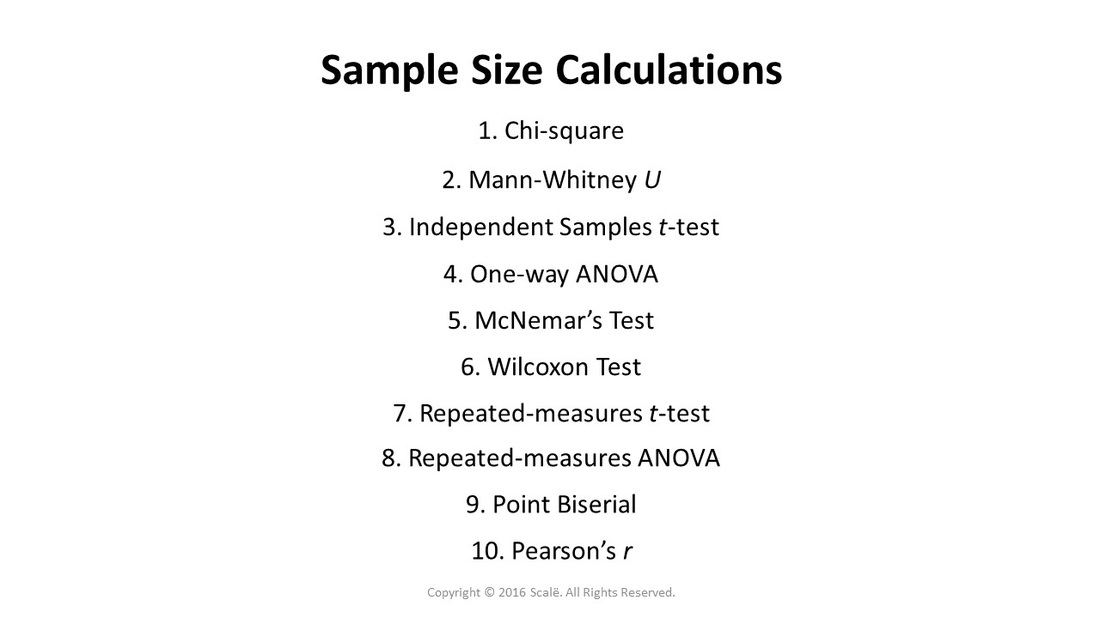Sample Size
Calculate sample size for ten different statistical tests using G*Power
Sample size plays an integral role in statistical power and the ability of researchers to make precise and accurate inferences. In order to calculate sample size, researchers have to know what type of effect size they are attempting to detect. Oftentimes, researchers have NO IDEA what their proposed effect size constitutes in regards to magnitude and variance.
The best choice for most researchers is to seek out published papers in the area of empirical interest that answer theoretically, conceptually, or physiologically similar research questions and use the reported values associated with the statistical results. This is known as using an evidence-based measure of effect size to plan an a priori sample size calculation. Sample size calculations using evidence-based measures of effect show more empirical rigor on the researchers' part and adds internal validity to the study.
Researchers should seek out the highest level of evidence at their disposal. Systematic reviews and synopses of syntheses produce the most precise and accurate evidence-based measures of effect size. Randomized controlled trials should be considered if no systematic reviews or syntheses exist in the empirical area. Observational studies should only be considered if higher levels of evidence do not exist in the current literature.
The best choice for most researchers is to seek out published papers in the area of empirical interest that answer theoretically, conceptually, or physiologically similar research questions and use the reported values associated with the statistical results. This is known as using an evidence-based measure of effect size to plan an a priori sample size calculation. Sample size calculations using evidence-based measures of effect show more empirical rigor on the researchers' part and adds internal validity to the study.
Researchers should seek out the highest level of evidence at their disposal. Systematic reviews and synopses of syntheses produce the most precise and accurate evidence-based measures of effect size. Randomized controlled trials should be considered if no systematic reviews or syntheses exist in the empirical area. Observational studies should only be considered if higher levels of evidence do not exist in the current literature.
Inclusion and exclusion criteria and sample size
One of the first things that researchers do when writing their research questions and designing a study is to objectively define the population of interest. In order to define a population from which a sample size will be taken, researchers use inclusion criteria (characteristics that members of the population of interest must possess to be included in the study) and exclusion criteria (characteristics that members of the population should not possess for purposes of sampling). Click on a button below to learn more about establishing these criteria for a population.
Sampling methods and sample size
There are two primary sampling methods that can be used in applied research: Probability and non-probability. Probability sampling is used in experimental designs where all members of a given population have an equal chance of being selected for participation in a trial, also known as random selection. Non-probability sampling is used in observational designs where the outcomes of interest have already occurred or when random selection is not feasible. Click on the Sampling Methods button below to learn more.
G*Power and sample size calculations
After finding the highest level of evidence and critically appraising its results in the context of the current empirical or clinical setting, the evidence-based measures of effect can be utilized in both a priori and post hoc power analyses. The open-source statistical power application, G*Power, is a towering contribution to the field of applied science.* G*Power provides researchers the ability to conduct many types of power analyses and provides a user-friendly interface. The methods for conducting sample size calculations for ten different statistical tests are presented below.
Click here to download G*Power: http://www.gpower.hhu.de/en.html
The Sample Size decision tree provides the methods for conducting and interpreting 10 sample size calculations using G*Power. Click on a button below to continue.
Click here to download G*Power: http://www.gpower.hhu.de/en.html
The Sample Size decision tree provides the methods for conducting and interpreting 10 sample size calculations using G*Power. Click on a button below to continue.
Methods for calculating sample size in G*Power
Sample size calculation for between-subjects analysis with two groups on a categorical outcome
Sample size calculation for between-subjects analysis with two groups on an ordinal outcome
Sample size calculation for between-subjects analysis with two groups on a continuous outcome
Sample size calculation for between-subjects analysis with three groups on a continuous outcome
Sample size calculation for within-subjects analysis with two observations of a categorical outcome
Sample size calculation for within-subjects analysis with two observations of an ordinal outcome
Sample size calculation for within-subjects analysis with two observations of a continuous outcome
Sample size calculation for within-subjects analysis with three observations of a continuous outcome
Sample size calculation for a correlation between a categorical variable and a continuous variable
Sample size calculation for a correlation between two continuous variables
Statistician For Hire
DO YOU NEED TO HIRE A STATISTICIAN?
Eric Heidel, Ph.D. will provide statistical consulting for your research study at $100/hour. Secure checkout is available with PayPal, Stripe, Venmo, and Zelle.
- Statistical Analysis
- Sample Size Calculations
- Diagnostic Testing and Epidemiological Calculations
- Psychometrics
*Faul, F., Erdfelder, E., Lang, A.-G., & Buchner, A. (2007). G*Power 3: A flexible statistical power analysis program for the social, behavioral, and biomedical sciences. Behavior Research Methods, 39, 175-191.
*Faul, F., Erdfelder, E., Buchner, A., & Lang, A,-G. (2009). Statistical power analyses using G*Power 3.1: Tests for correlation and regression analyses. Behavior Research Methods, 41, 1149-1160.
*Faul, F., Erdfelder, E., Buchner, A., & Lang, A,-G. (2009). Statistical power analyses using G*Power 3.1: Tests for correlation and regression analyses. Behavior Research Methods, 41, 1149-1160.

